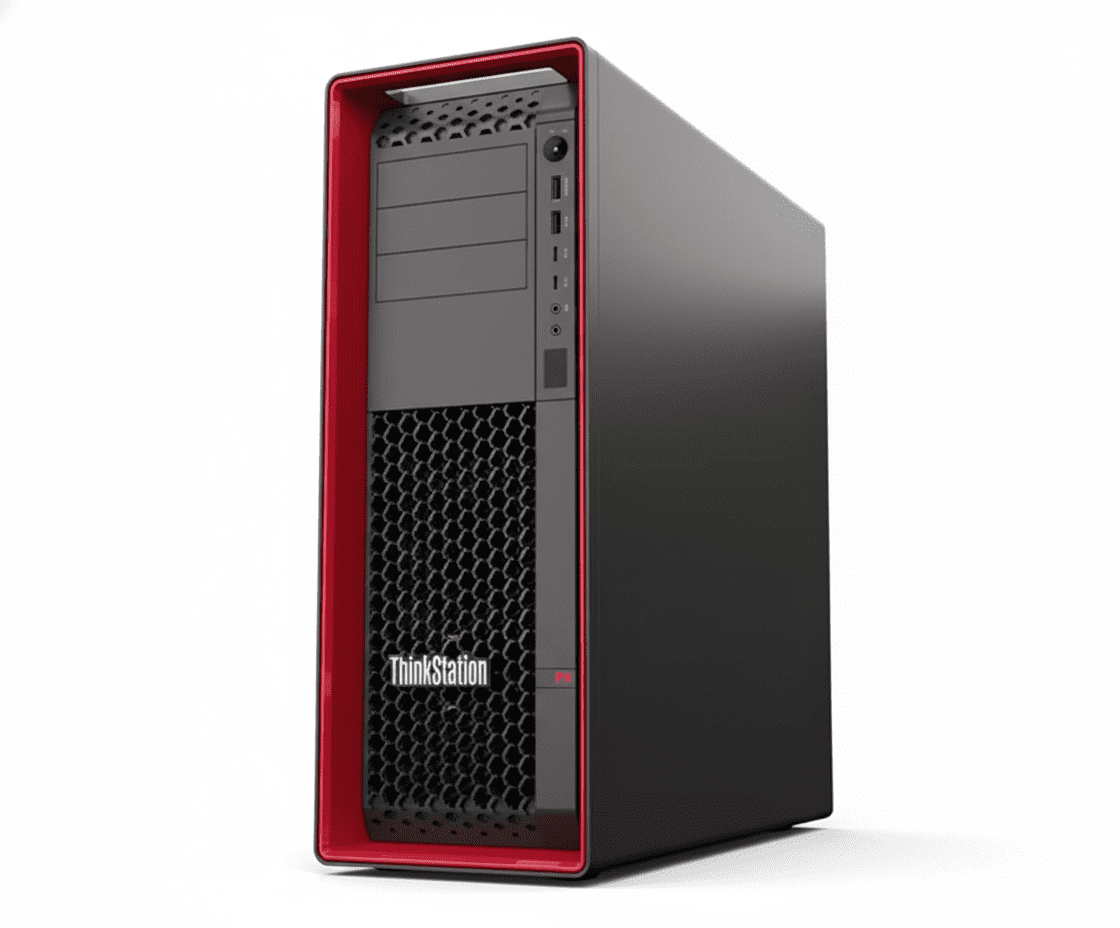
Lenovo ThinkStation P5 Review: Xeon W Workhorse with Pro-Grade Scalability
The Lenovo ThinkStation P5 is a future-proof, cross‑industry workstation built around Intel Xeon W3-2425 and ECC DDR5, with a base configuration that’s ready for certified pro apps and a chassis designed for tool‑less upgrades. Starting with 16GB RDIMM ECC, a 2TB 7200rpm HDD, and No OS, it can be customized up to NVIDIA RTX 6000 Ada 48GB for VFX, complex CAD, and AI-accelerated workloads. At ₹2,32,631 (8% off MRP), it targets teams that need certified reliability with ample headroom.
Ready to Build Your Pro-Grade Workstation?
Scale from entry Xeon W to dual high-end RTX for BIM, complex 3D CAD, VFX, and edge deployments.
Use eCoupon: CUSTOMOFF | Exchange bonus up to ₹20,000 | My Lenovo Rewards: 9,857
Key Features at a Glance
1. Processor Performance: Workstation-Class Reliability
Designed for certified stability across complex, compute‑intensive workflows.
Intel Xeon W3-2425
6 cores/12 threads with up to 4.4GHz Turbo and 15MB cache delivers predictable performance for CAD, BIM, VFX, and scientific apps with ECC memory integrity.
Thermals & Power Headroom
Advanced airflow and high‑efficiency PSUs (750W/1000W) sustain boost clocks under load and leave room for future dual‑GPU configurations.
ISV-Certified Confidence
Validated with leading ISVs so production pipelines remain stable and supported—critical for mission‑dependent environments.
2. Graphics & Expansion: Scale Visual and AI Power
Start simple, expand to top‑tier rendering and simulation.
From No dGPU to RTX 6000 Ada
The base config ships without a discrete GPU for budget control, but the platform supports up to dual professional RTX cards for massive compute and VRAM needs.
PCIe & Display Flexibility
Multiple PCIe slots for GPUs, high‑speed storage, and I/O cards. Configure extensive multi‑display environments for complex timelines or model views.
Front-Access & Hot-Swap
Front-access M.2 bay and hot-swap options streamline on‑site service and rapid media cycling without disrupting active projects.
3. Design & Cooling: Aston Martin‑Inspired, Tool‑Less
Engineered for uptime, serviceability, and clean airflow.
Chassis & Serviceability
33L tower with labeled internals and tool‑less latches speeds upgrades to GPU, RAM, and storage—even on tight production schedules.
Thermal Architecture
Segmented airflow zones and high‑capacity heatsinks reduce hotspots for reliable boosts during long renders and simulations.
Security & Durability
ThinkShield features (dTPM 2.0, BIOS protections) and rugged build quality support enterprise security and field‑tested reliability.
4. Storage & Memory: Massive, Fast, and Protected
ECC memory and multi‑drive arrays for large, sensitive projects.
Base to Enterprise Arrays
Ships with 2TB 7200rpm HDD; expand up to 10 total drives (3x 3.5″ + 7x M.2) with RAID options for redundancy and throughput.
ECC DDR5 Capacity
Start at 16GB RDIMM ECC and scale to 512GB across 8 DIMM slots to keep multi‑app workflows responsive and stable.
Front M.2 Access
Front-access M.2 simplifies secure media handling and rapid capacity changes between jobs.
5. Connectivity: Flexible, High-Bandwidth I/O
Front and rear high‑speed ports for modern pipelines.
Front I/O
Headphone/mic combo, optional 2x USB‑A 3.2 Gen2 (10Gbps), optional 2x USB‑C 3.2 Gen2 (10Gbps).
Rear I/O & Expansion
RJ‑45 Gigabit Ethernet, USB‑A 2.0, USB‑A 3.2 Gen2 (10Gbps), USB‑C 3.2 Gen2x2, line in/out, optional serial, plus multiple PCIe slots for add‑in cards.
Multi‑Display Workflows
Configure expansive multi‑monitor setups through professional GPUs and additional I/O modules as needed.
Ideal For These Users
Certified performance and ECC memory integrity for large assemblies and parametric modeling.
Scale to dual RTX for ray tracing, denoising, compositing, and high‑res timelines.
Front M.2 access and ISV validation shorten iteration loops and reduce downtime.
Reliable thermals, robust PSUs, and security stack for 24/7 mission‑critical tasks.
Tool‑less service, long lifecycle, and strong vendor support simplify fleet management.
Start with base config; add RAM, SSD arrays, and GPUs as project scope expands.
Competitive Edge: How It Stacks Up
A balanced blend of ISV assurance, serviceability, and growth potential.
-
Vs HP Z4 G5
Comparable Xeon W platform; P5’s front M.2 access and tool‑less layout improve on‑site service and rapid storage turnover.
-
Vs Dell Precision 5860 Tower
P5 offers clean thermals and clear upgrade paths to dual RTX while maintaining competitive pricing for ECC memory capacity.
-
Value & Lifecycle
ISV certification, enterprise security, and long platform support reduce total cost of ownership for studios and labs.
-
Serviceability
Tool‑less chassis and labeled internals minimize downtime versus consumer towers in production environments.
Full Specifications
General
Processor
Memory
Storage
Graphics
Connectivity & I/O
Power & Thermals
Software & Security
Pros and Cons
Pros
- ISV‑Certified Platform: Reliable for mission‑critical pipelines.
- Tool‑Less Serviceability: Faster upgrades and maintenance.
- Front‑Access M.2: Hot‑swap friendly media handling.
- ECC DDR5 Capacity: Up to 512GB across 8 DIMMs.
- GPU Headroom: Scale to dual pro RTX for top‑tier workloads.
Cons
- Base Lacks dGPU: Immediate 3D/VFX users should configure a pro GPU.
- HDD‑Only Base: Add NVMe SSD for OS/scratch speed.
- 16GB RAM Base: Heavy pipelines will need more ECC memory.
- No OS by Default: Plan Windows/Red Hat licensing early.
- Large Tower: Requires adequate space/airflow.
Who Might Consider Other Options
Budget‑Only Buyers
Entry desktops/workstations with consumer CPUs may suffice for office‑first tasks without ECC or ISV needs.
Max‑Core Compute
For ultra‑high core counts or multi‑socket needs, step to higher‑tier workstations (e.g., P7/PX lines).
Ultra‑Compact Spaces
Small‑form options are better if acoustic or footprint constraints dominate your environment.
Immediate 4K Editorial/VFX
Configure with NVMe OS/scratch and a pro RTX at purchase to avoid day‑one bottlenecks.
Final Verdict
ThinkStation P5 nails the workstation sweet spot: certified stability, excellent serviceability, and abundant upgrade paths—from ECC RAM to dual pro RTX. The base config is intentionally lean; add NVMe and a pro GPU to unleash its full potential for BIM, complex CAD, VFX, and AI‑assisted pipelines.